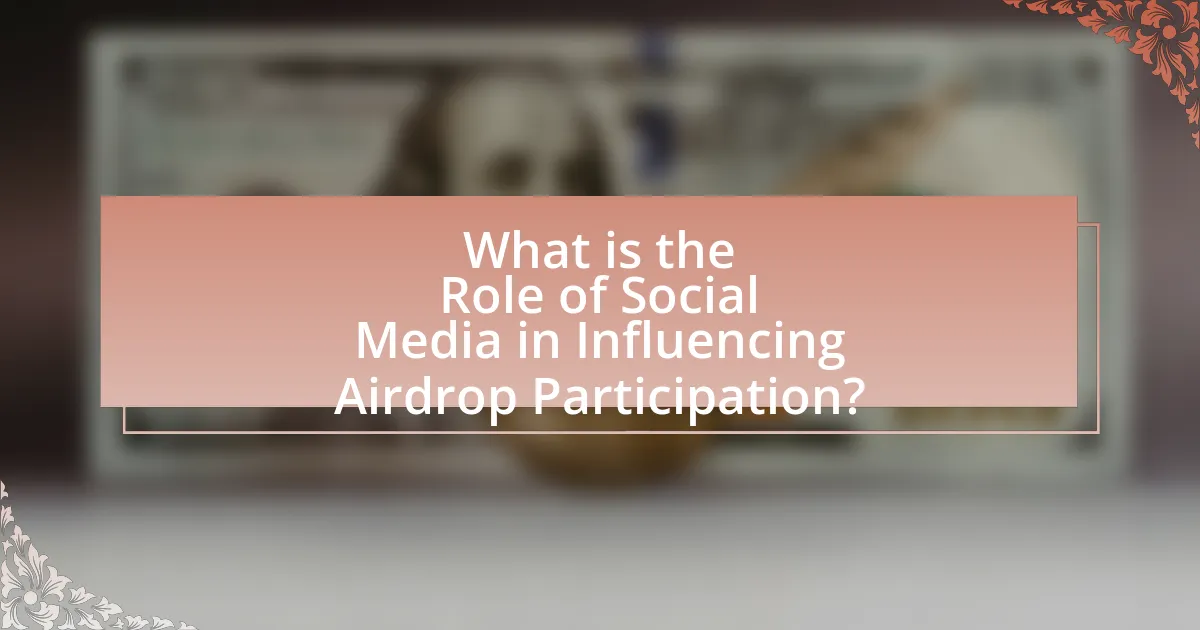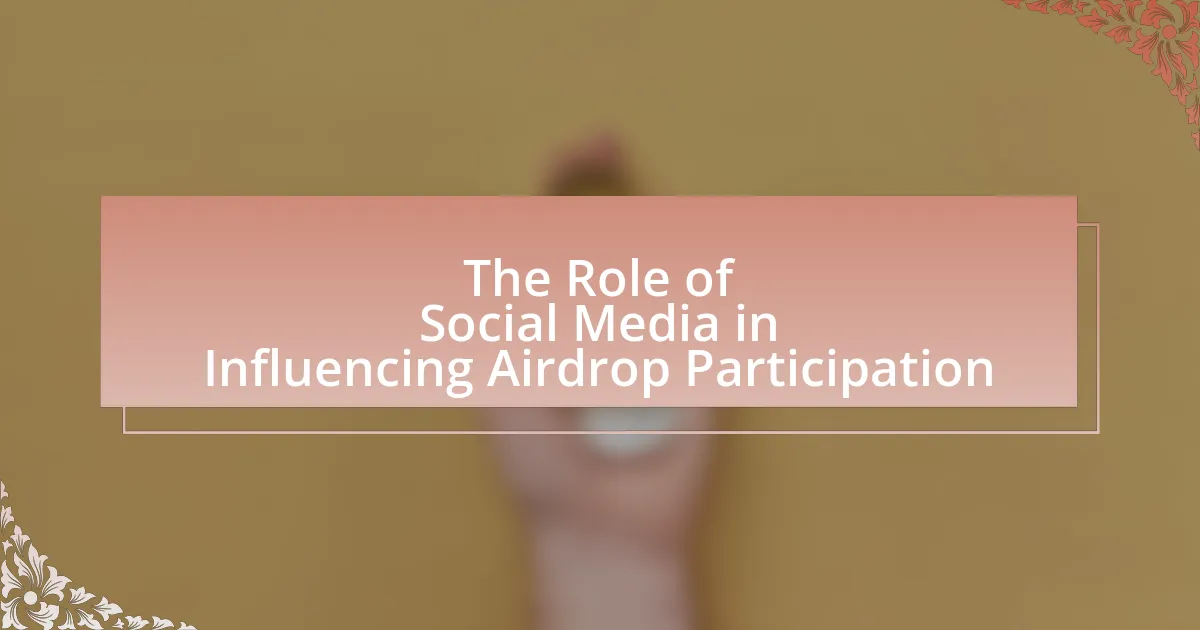The article examines the significant role of social media in influencing airdrop participation within the cryptocurrency space. It highlights how platforms such as Twitter, Telegram, and Discord facilitate communication, enhance user awareness, and foster community engagement, ultimately driving participation rates. Key factors discussed include the effectiveness of various social media platforms, the impact of algorithms on visibility, the importance of engagement metrics, and strategies to mitigate misinformation. Additionally, the article explores best practices for leveraging social media, the role of influencers, and future trends that may shape airdrop campaigns.

What is the Role of Social Media in Influencing Airdrop Participation?
Social media plays a crucial role in influencing airdrop participation by facilitating communication and engagement between projects and potential participants. Platforms like Twitter, Telegram, and Discord allow projects to announce airdrops, share updates, and create communities around their tokens, significantly increasing visibility and interest. For instance, a study by the Cambridge Centre for Alternative Finance found that 80% of cryptocurrency investors rely on social media for information, highlighting its impact on decision-making. Additionally, social media enables viral marketing, where participants share airdrop opportunities with their networks, further amplifying reach and participation rates.
How does social media impact user awareness of airdrops?
Social media significantly enhances user awareness of airdrops by facilitating real-time information sharing and community engagement. Platforms like Twitter, Telegram, and Reddit serve as primary channels where users receive updates about upcoming airdrops, often directly from project teams or community influencers. For instance, a study by the Cambridge Centre for Alternative Finance found that 70% of cryptocurrency users rely on social media for news and updates, highlighting its critical role in disseminating information. This immediate access to information not only increases awareness but also fosters a sense of community among users, encouraging participation in airdrop events.
What platforms are most effective for promoting airdrops?
Twitter, Telegram, and Discord are the most effective platforms for promoting airdrops. Twitter’s large user base and real-time engagement allow for rapid dissemination of information, while Telegram provides a space for community interaction and direct communication with potential participants. Discord facilitates organized discussions and community building, which can enhance trust and participation in airdrops. According to a study by the Cambridge Centre for Alternative Finance, social media platforms significantly influence cryptocurrency engagement, with Twitter being a primary source for news and updates in the crypto space.
How do social media algorithms affect airdrop visibility?
Social media algorithms significantly affect airdrop visibility by determining which posts are shown to users based on engagement metrics and user preferences. These algorithms prioritize content that generates high interaction rates, meaning that airdrops promoted through engaging visuals, compelling narratives, or influencer endorsements are more likely to reach a broader audience. For instance, platforms like Twitter and Instagram utilize algorithms that favor posts with higher likes, shares, and comments, thereby amplifying the visibility of airdrop announcements that resonate well with users. Consequently, airdrops that leverage effective social media strategies can achieve greater exposure and participation rates, as evidenced by campaigns that have successfully utilized viral marketing techniques to enhance their reach.
Why is social media engagement important for airdrop success?
Social media engagement is crucial for airdrop success because it amplifies visibility and fosters community participation. High engagement rates on platforms like Twitter and Telegram can lead to increased awareness of the airdrop, attracting more participants. For instance, a study by the Cambridge Centre for Alternative Finance found that projects with active social media engagement saw a 30% higher participation rate in token distributions compared to those with minimal online presence. This correlation highlights that effective communication and interaction on social media not only inform potential participants but also build trust and excitement around the airdrop, ultimately driving its success.
What types of content drive engagement for airdrop promotions?
Visual content, such as infographics and videos, drives high engagement for airdrop promotions. Research indicates that posts with visuals receive 94% more views than text-only content, making them more effective in capturing attention. Additionally, interactive content like polls and quizzes encourages user participation, further enhancing engagement. A study by HubSpot found that interactive content generates twice the engagement of static content, demonstrating its effectiveness in airdrop campaigns.
How does community interaction influence airdrop participation rates?
Community interaction significantly enhances airdrop participation rates by fostering trust and engagement among potential participants. When communities actively discuss and promote airdrops on social media platforms, they create a sense of belonging and urgency, which motivates individuals to participate. For instance, a study by the Cambridge Centre for Alternative Finance found that projects with higher community engagement on platforms like Twitter and Telegram experienced a 30% increase in airdrop participation compared to those with minimal interaction. This correlation indicates that vibrant community discussions and shared experiences can effectively drive higher participation rates in airdrops.
What are the challenges of using social media for airdrop campaigns?
The challenges of using social media for airdrop campaigns include misinformation, audience targeting, and regulatory compliance. Misinformation can lead to skepticism among potential participants, reducing trust in the campaign. Audience targeting is crucial, as reaching the right demographic is often difficult; campaigns may attract users who are not genuinely interested in the project, leading to low engagement rates. Regulatory compliance poses another challenge, as different jurisdictions have varying laws regarding cryptocurrency promotions, which can complicate campaign execution and increase legal risks. These factors collectively hinder the effectiveness of social media as a platform for airdrop campaigns.
How can misinformation on social media affect airdrop participation?
Misinformation on social media can significantly reduce airdrop participation by creating confusion and distrust among potential participants. When false information circulates, such as misleading details about eligibility or the legitimacy of the airdrop, individuals may hesitate to engage, fearing scams or loss of funds. For instance, a study by the Pew Research Center found that 64% of Americans believe misinformation has caused confusion about basic facts, which can directly impact their willingness to participate in cryptocurrency initiatives like airdrops. This distrust can lead to lower engagement rates and ultimately diminish the success of airdrop campaigns.
What strategies can mitigate negative social media impacts on airdrops?
To mitigate negative social media impacts on airdrops, implementing a robust communication strategy is essential. This strategy should include proactive engagement with the community to address concerns and misinformation promptly. For instance, regular updates and transparent communication about the airdrop’s purpose, eligibility criteria, and distribution process can help build trust and reduce skepticism. Additionally, leveraging social media monitoring tools to track sentiment and respond to negative comments can further enhance community relations. Research indicates that companies that actively engage with their audience on social media experience a 20% increase in positive sentiment, which can directly influence airdrop participation rates.
How can social media strategies be optimized for better airdrop results?
Social media strategies can be optimized for better airdrop results by targeting specific demographics and utilizing engaging content formats. Targeting specific demographics ensures that the airdrop reaches individuals who are more likely to participate, as evidenced by a study from the Digital Marketing Institute, which found that targeted campaigns can increase engagement rates by up to 50%. Engaging content formats, such as videos and interactive posts, can capture attention more effectively; research from HubSpot indicates that video content is shared 1,200% more than text and images combined. Additionally, leveraging influencers within the crypto space can amplify reach and credibility, as influencer marketing has been shown to yield a return on investment of $6.50 for every dollar spent, according to a report by Influencer Marketing Hub.
What metrics should be tracked to measure social media effectiveness in airdrop campaigns?
To measure social media effectiveness in airdrop campaigns, key metrics include engagement rate, reach, conversion rate, and sentiment analysis. Engagement rate quantifies interactions such as likes, shares, and comments relative to total followers, indicating audience interest. Reach measures the total number of unique users who see the campaign content, reflecting visibility. Conversion rate tracks the percentage of users who complete the desired action, such as signing up for the airdrop, showcasing campaign effectiveness. Sentiment analysis evaluates the tone of user comments and interactions, providing insight into public perception. These metrics collectively offer a comprehensive view of social media performance in driving airdrop participation.
How do engagement rates correlate with airdrop participation?
Engagement rates positively correlate with airdrop participation, as higher engagement typically indicates greater interest and involvement from the community. Studies show that projects with active social media engagement, such as likes, shares, and comments, often experience increased participation in their airdrop campaigns. For instance, a report by CoinMarketCap found that projects with engagement rates above 5% saw a 30% higher participation rate in their airdrops compared to those with lower engagement. This trend suggests that effective social media strategies can enhance community involvement in airdrop initiatives.
What tools can help analyze social media performance for airdrops?
Tools that can help analyze social media performance for airdrops include Hootsuite, Sprout Social, and Google Analytics. Hootsuite allows users to track engagement metrics across multiple social media platforms, providing insights into audience interaction with airdrop announcements. Sprout Social offers detailed analytics on post performance and audience demographics, which can help refine targeting strategies for airdrops. Google Analytics can track referral traffic from social media to airdrop landing pages, enabling the measurement of conversion rates and overall effectiveness of social media campaigns. These tools collectively provide comprehensive data that can enhance the strategy and execution of airdrop promotions.
What best practices should be followed for leveraging social media in airdrop campaigns?
To effectively leverage social media in airdrop campaigns, brands should focus on clear communication, targeted audience engagement, and strategic partnerships. Clear communication involves outlining the airdrop’s purpose, eligibility criteria, and steps to participate, ensuring potential participants understand the value proposition. Targeted audience engagement can be achieved by utilizing analytics tools to identify and reach specific demographics that align with the project’s goals, thereby increasing participation rates. Strategic partnerships with influencers or relevant communities can amplify reach and credibility, as studies show that influencer marketing can yield a return on investment of up to $6.50 for every dollar spent. These best practices enhance visibility and encourage active participation in airdrop campaigns.
How can brands create compelling narratives around their airdrops on social media?
Brands can create compelling narratives around their airdrops on social media by focusing on storytelling that highlights the value and purpose of the airdrop. Engaging narratives can include the brand’s mission, the benefits of participating in the airdrop, and real-life use cases of the tokens being distributed. For instance, brands can share testimonials from early adopters or showcase how the airdrop contributes to community building or innovation within the industry.
Additionally, incorporating visuals, such as infographics or videos, can enhance the narrative by making it more relatable and shareable. According to a study by HubSpot, content with relevant images gets 94% more views than content without images, emphasizing the importance of visual storytelling in social media engagement. By combining these elements, brands can effectively capture attention and encourage participation in their airdrops.
What role do influencers play in promoting airdrop participation?
Influencers play a crucial role in promoting airdrop participation by leveraging their large followings to disseminate information and create buzz around airdrop campaigns. Their established credibility and engagement with audiences can significantly increase awareness and interest in airdrops, leading to higher participation rates. For instance, a study by the Digital Marketing Institute found that 49% of consumers depend on influencer recommendations for their purchasing decisions, indicating that influencers can effectively drive user engagement in cryptocurrency airdrops.
What are the future trends in social media and airdrop participation?
Future trends in social media and airdrop participation include increased integration of decentralized finance (DeFi) platforms and enhanced user engagement through gamification. Social media platforms are evolving to facilitate direct interactions between projects and potential participants, fostering community-driven initiatives. For instance, platforms like Twitter and Discord are becoming essential for real-time updates and community discussions, which can significantly influence airdrop success rates. Additionally, data from a 2023 survey by CoinMarketCap indicates that 70% of crypto users prefer participating in airdrops promoted through social media channels, highlighting the growing reliance on these platforms for project visibility and user acquisition.
How can emerging technologies enhance social media’s role in airdrop campaigns?
Emerging technologies can enhance social media’s role in airdrop campaigns by enabling targeted marketing, improving user engagement, and facilitating real-time analytics. For instance, artificial intelligence algorithms can analyze user behavior and preferences, allowing brands to tailor their airdrop messages to specific demographics, thereby increasing participation rates. Additionally, blockchain technology can ensure transparency and security in the distribution process, fostering trust among users. According to a study by Deloitte, 70% of consumers are more likely to engage with brands that utilize personalized marketing strategies, demonstrating the effectiveness of these technologies in driving airdrop success.
What innovations are expected to shape social media marketing for airdrops?
Innovations expected to shape social media marketing for airdrops include the integration of artificial intelligence for targeted advertising, the use of blockchain technology for transparency, and the rise of interactive content formats. Artificial intelligence enables marketers to analyze user behavior and preferences, allowing for more personalized and effective ad campaigns. Blockchain technology enhances trust by providing verifiable records of airdrop distributions, which can be shared on social media platforms. Additionally, interactive content such as polls, quizzes, and live streams can engage users more effectively, driving higher participation rates in airdrops. These innovations collectively enhance user experience and increase the likelihood of successful airdrop campaigns.
What practical tips can improve social media strategies for airdrop participation?
To improve social media strategies for airdrop participation, organizations should focus on targeted audience engagement, clear communication of benefits, and consistent updates. Targeted audience engagement involves identifying and reaching out to specific user demographics that are likely to participate in airdrops, which can increase participation rates. Clear communication of benefits ensures that potential participants understand the value of the airdrop, such as potential financial gains or exclusive access to products. Consistent updates keep the audience informed and engaged, fostering a sense of community and urgency around the airdrop event. These strategies are supported by studies showing that targeted marketing can increase conversion rates by up to 50%, highlighting the effectiveness of tailored approaches in social media campaigns.


